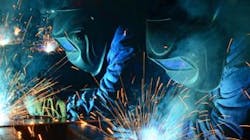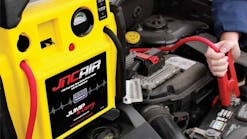Welding fume: What is it and what damage may be caused by it?
Welding, glittering sparks and graceful curling fume are inseparable. It's almost a romantic image, with hard-working welders in the middle. However, the romance evaporates quickly if you understand what welding fumes are and what their composition may be.
Welding fumes are dangerous and very threatening to person's health. This is especially in scenarios where specialists have not analysed a specific work environment and/or no security measures have been taken.
Composition of the fume
Welding fume is a varying mixture of airborne gases and fine particles. The composition of the mixture depends on the welding method and the products that are welded. Gases that may be released include:
- Nitrous oxide (NOx)
- Carbon dioxide (CO2)
- Carbon monoxide (CO)
- Shielding gas
- Ozone (O3)
Also, it fume contain a lot of fine particles of metallic oxides, fluorides and metals, such as:
- Chromium
- Nickel
- Zinc
- Manganese
- Cobalt
- Lead
- Copper
Particles constitute the greatest health hazard
Welding fume particles are less than 1 μm, that is 0.001 mm in diameter, when produced. But they increase in size when in due time particles stick together. Particles develop with time. The 1-7 μm diameter particles constitute the greatest health hazard because of their ability to penetrate deep into the lungs and because they are not readily cleared by the cilia lining the respiratory tract. The particles visible in the fume plume are usually heavier, that is, larger, particles which will rapidly precipitate onto adjacent surfaces as ‘dust fall’. Particles in the welder's breathing zone are usually 2 μm or less. These lighter, smaller, particles may remain in the air for some hours if not removed by ventilation.
Welding fumes can cause serious diseases
It is pretty obvious that it is potentially dangerous to inhale such welding fumes. Many scientific studies and reports state that welding fumes can cause all kinds of physical complaints and serious diseases such as cancer, asthma and even symptoms of Parkinson’s disease.
Three factors determine the risks
The level of the risk, if no adjuvant ventilation and protective measures are taken, depends on three factors:
- The toxicity of the fume
- The concentration of the fume
- How long the fume has been inhaled
1. Toxicity of the welding fume
The toxicity of the fume varies. It depends on the type of welding process, the welding materials used and what kind of material is being welded. In future blogs we will write more about fumes from, for instance, mild steel welding, stainless steel welding or welding of metals that are coated, and about the fume development in specific welding products and processes.
2. Concentration of the welding fume
The concentration of the fume and the harmful substances are the highest in the plume of fume that rises from the welding point. The faster this fume is eliminated by ventilation, the better.
3. Duration of inhaling welding fumes
How long a welder may be inhaling such a fume depends on the time he is actually welding. Some fabricators weld one or two hours a day, others weld all day long. A simple calculus, also called the arcing time, shows the longer one welds, the more fume is being produced and the greater the danger of inhaling the mixture of airborne gases and fine particles.
Information provided by: Plymovent (www.plymovent.com)


